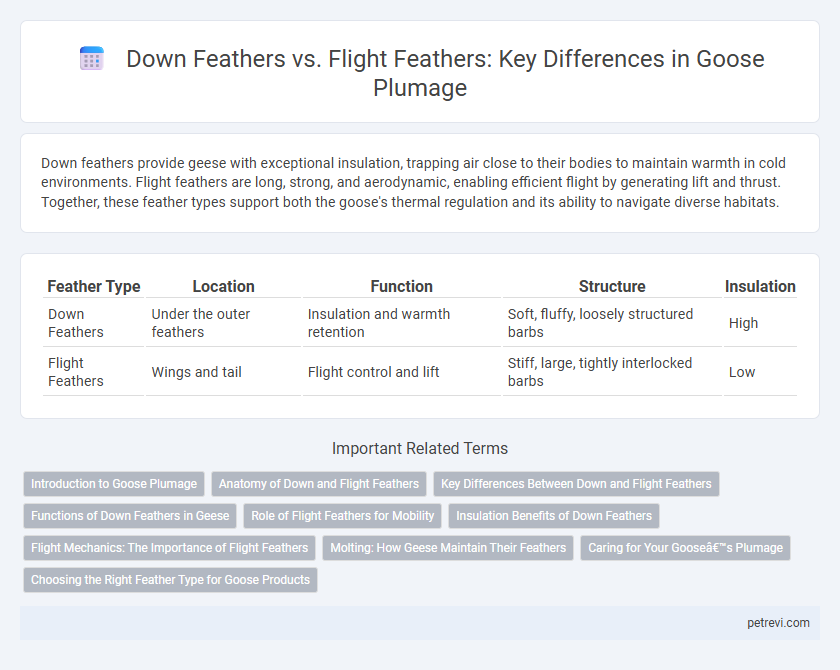Down feathers provide geese with exceptional insulation, trapping air close to their bodies to maintain warmth in cold environments. Flight feathers are long, strong, and aerodynamic, enabling efficient flight by generating lift and thrust. Together, these feather types support both the goose's thermal regulation and its ability to navigate diverse habitats.
Table of Comparison
| Feather Type | Location | Function | Structure | Insulation |
|---|---|---|---|---|
| Down Feathers | Under the outer feathers | Insulation and warmth retention | Soft, fluffy, loosely structured barbs | High |
| Flight Feathers | Wings and tail | Flight control and lift | Stiff, large, tightly interlocked barbs | Low |
Introduction to Goose Plumage
Goose plumage consists primarily of down feathers and flight feathers, each serving distinct functions essential to the bird's survival. Down feathers provide superior insulation by trapping air close to the body, maintaining warmth in cold environments. Flight feathers, found on the wings and tail, are rigid and aerodynamic, enabling powerful and controlled flight necessary for migration and evasion from predators.
Anatomy of Down and Flight Feathers
Goose plumage features distinct anatomical differences between down feathers and flight feathers, with down feathers possessing soft, fine barbs that lack interlocking barbules, providing superior insulation by trapping air close to the skin. In contrast, flight feathers exhibit rigid rachises and closely interlocked barbules forming a smooth, aerodynamic surface essential for lift and flight control. The structural specialization in flight feathers includes asymmetrical vanes for improved aerodynamics, while down feathers prioritize thermal regulation.
Key Differences Between Down and Flight Feathers
Down feathers in geese provide superior insulation due to their soft, fluffy structure that traps warmth close to the body, while flight feathers are rigid and streamlined, essential for aerodynamic efficiency during flight. Flight feathers, primarily located on the wings and tail, have a strong central rachis and interlocking barbs that maintain shape and support lift generation. In contrast, down feathers lack this stiffness and interlocking mechanism, making them ideal for retention of body heat but unsuitable for flight functions.
Functions of Down Feathers in Geese
Down feathers in geese serve as an essential insulating layer, trapping warm air close to the bird's body to maintain optimal body temperature in cold environments. These soft, fluffy feathers provide superior thermal regulation by minimizing heat loss compared to the stiffer, more rigid flight feathers that are primarily designed for aerodynamic efficiency. The specialized structure of down feathers, with their fine barbs and lack of a central shaft, creates air pockets that enhance insulation, crucial for goslings and adult geese during migration and winter months.
Role of Flight Feathers for Mobility
Flight feathers in geese are essential for enabling powerful and efficient wingbeats, facilitating sustained flight and long migratory journeys. These feathers have a robust structure with interlocking barbules that provide the necessary aerodynamic surface area and strength for lift and thrust. Unlike down feathers, which primarily offer insulation, flight feathers play a critical role in mobility by allowing precise control and maneuverability during flight.
Insulation Benefits of Down Feathers
Down feathers in goose plumage provide superior insulation by trapping a dense layer of warm air close to the skin, significantly reducing heat loss in cold environments. Their soft, fluffy structure contrasts with the stiff, aerodynamic flight feathers that prioritize lift and maneuverability over thermal regulation. This insulation capability of down feathers is crucial for geese, enabling efficient temperature control during migration and harsh weather conditions.
Flight Mechanics: The Importance of Flight Feathers
Flight feathers play a crucial role in the flight mechanics of geese, providing the necessary lift and thrust during takeoff, gliding, and landing. Unlike down feathers, which offer insulation by trapping air close to the body, flight feathers are stiff, aerodynamic, and arranged in a precise pattern along the wings to maximize airflow control. Their strength and flexibility enable geese to achieve efficient flight dynamics, maneuverability, and energy conservation across long migratory journeys.
Molting: How Geese Maintain Their Feathers
Down feathers provide insulation by trapping air close to a goose's body, while flight feathers are crucial for aerodynamic support and maneuverability during flight. During molting, geese sequentially shed and replace these feathers to maintain optimal insulation and flight capability without compromising mobility. This process ensures that newly grown feathers are fully functional for thermal regulation and aerodynamic efficiency in successive seasons.
Caring for Your Goose’s Plumage
Down feathers provide exceptional insulation for geese, maintaining body heat in cold weather by trapping air close to the skin. Flight feathers are essential for mobility and protection, requiring regular preening and occasional trimming to prevent damage and maintain aerodynamic function. Proper care of both down and flight feathers involves ensuring the goose's habitat remains clean and dry, supporting natural molting cycles and keeping feathers in optimal condition.
Choosing the Right Feather Type for Goose Products
Down feathers provide exceptional insulation for goose products, offering superior warmth and softness ideal for bedding and outerwear. Flight feathers, characterized by their stiffness and durability, deliver structure and waterproofing necessary for high-performance items like down jackets and sleeping bags. Selecting the right feather type depends on balancing thermal efficiency with durability, ensuring optimal comfort and longevity in goose-derived products.
Down Feathers vs Flight Feathers for Goose Plumage Infographic

 petrevi.com
petrevi.com